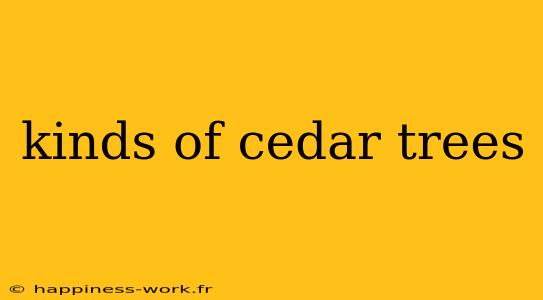Cedar trees are known for their beautiful wood, aromatic scent, and numerous benefits. They belong to the family of coniferous trees and are primarily found in the northern hemisphere. With various species and characteristics, understanding the different kinds of cedar trees can enhance your landscaping choices or woodworking projects.
What Are Cedar Trees?
Cedar trees are evergreen conifers that belong to the genus Cedrus. They are renowned for their durability, resistance to decay, and attractive grain patterns, making them highly sought after for construction, furniture making, and crafting. Beyond their practical uses, cedars also provide aesthetic and ecological benefits, serving as habitats for wildlife and contributing to overall biodiversity.
Main Types of Cedar Trees
1. Atlas Cedar (Cedrus atlantica)
Characteristics:
- Native to the Atlas Mountains of Morocco and Algeria.
- Has blue-green needles that create a stunning visual contrast.
- Grows to about 40 to 60 feet tall.
Uses:
- Popular as an ornamental tree in landscapes.
- Its wood is highly valued for its beautiful grain and aromatic properties.
2. Deodar Cedar (Cedrus deodara)
Characteristics:
- Originates from the western Himalayas.
- Can reach heights of 40 to 70 feet.
- Features long, pendulous branches with soft, feathery needles.
Uses:
- Often used in traditional building methods in its native regions.
- Its wood is prized for making furniture, while its aesthetic appeal makes it a favorite in gardens.
3. Lebanon Cedar (Cedrus libani)
Characteristics:
- Native to the Mediterranean region, particularly in Lebanon.
- A majestic tree that can grow to 40 to 80 feet tall.
- Sturdy and resilient with a wide, spreading crown.
Uses:
- Historically used in temple construction, notably by the ancient Egyptians.
- Its wood is resistant to insects and decay, making it ideal for outdoor structures.
4. Cyprian Cedar (Cedrus brevifolia)
Characteristics:
- Found only on the island of Cyprus.
- Similar in appearance to the Lebanon cedar but smaller and bushier.
- Typically grows to about 20 to 50 feet tall.
Uses:
- Its limited geographical range makes it less commonly used, but its unique features are valued in landscape design.
Why Choose Cedar Trees?
Aesthetic Appeal
Cedar trees are not only functional but also enhance the beauty of any landscape. Their unique shapes, colors, and aromatic foliage make them a great choice for gardens and parks.
Durability and Resistance
Cedar wood is naturally resistant to moisture, decay, and insect infestations. This characteristic makes it an excellent choice for outdoor furniture, decks, and siding.
Ecological Benefits
Cedar trees provide essential habitats for various wildlife. They can support a range of organisms, including birds and insects, contributing to a balanced ecosystem.
Conclusion
Choosing the right type of cedar tree depends on your specific needs, whether for aesthetic appeal or practical applications. Each species has its unique characteristics and benefits, making them versatile additions to any landscape.
Practical Example
If you are looking for a majestic tree to provide shade in your garden, the Deodar Cedar is an excellent option due to its height and aesthetic appeal. On the other hand, if you're interested in crafting outdoor furniture that lasts, the Lebanon Cedar is a strong contender due to its durability.
Additional Tips
- When planting cedar trees, consider their mature height and spread to avoid overcrowding.
- Regular pruning will help maintain their shape and health.
- Look for local nurseries or landscape professionals who can provide specific guidance based on your climate and soil conditions.
By understanding the different kinds of cedar trees and their unique features, you can make informed choices that enrich your landscape and fulfill your woodworking needs.
This article draws on the knowledge about cedar trees and enhances it with additional insights and practical applications, ensuring a comprehensive and engaging read for those interested in these remarkable trees. For further information, please refer to original resources available on platforms like WikiHow, which provide a wealth of gardening and landscaping tips.
